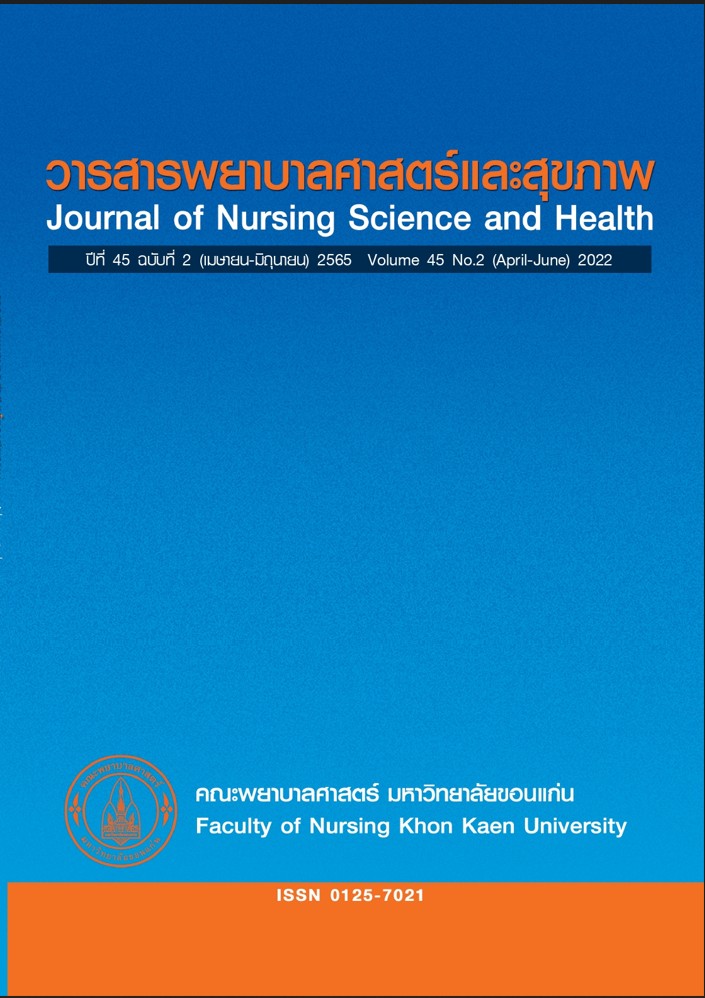ผลของโปรแกรมส่งเสริมการฟื้นตัวหลังผ่าตัด ต่อการรับรู้สมรรถนะแห่งตน คุณภาพการฟื้นตัวหลังผ่าตัด และภาวะแทรกซ้อนหลังผ่าตัดในผู้ป่วยมะเร็งท่อน้ำดี
คำสำคัญ:
ผู้ป่วยมะเร็งท่อน้ำดี, โปรแกรมส่งเสริมการฟื้นตัวหลังผ่าตัด, การรับรู้สมรรถนะแห่งตน, คุณภาพการฟื้นตัวหลังผ่าตัด, ภาวะแทรกซ้อนหลังผ่าตัดบทคัดย่อ
การวิจัยกึ่งทดลองนี้ มีวัตถุประสงค์เพื่อศึกษาผลของโปรแกรมส่งเสริมการฟื้นตัวหลังผ่าตัดต่อการรับรู้สมรรถนะแห่งตน คุณภาพการฟื้นตัวหลังผ่าตัด และภาวะแทรกซ้อนหลังผ่าตัดในผู้ป่วยมะเร็งท่อน้ำดี กลุ่มตัวอย่างเป็นผู้ป่วยมะเร็งท่อน้ำดีที่ได้รับการผ่าตัดและเข้ารับการรักษา ณ หอผู้ป่วยของแผนกผู้ป่วยใน โรงพยาบาลตติยภูมิแห่งหนึ่งในภาคตะวันออกเฉียงเหนือจำนวน 32 ราย แบ่งเป็นกลุ่มควบคุมและกลุ่มทดลองกลุ่มละ 16 ราย โดยกลุ่มควบคุมได้รับการพยาบาลตามมาตรฐาน และกลุ่มทดลองได้รับโปรแกรมส่งเสริมการฟื้นตัวหลังผ่าตัดที่ประยุกต์ใช้ทฤษฎีการรับรู้สมรรถนะแห่งตนของแบนดูรา เก็บรวบรวมข้อมูลโดยใช้แบบประเมินการรับรู้สมรรถนะแห่งตน แบบประเมินคุณภาพการฟื้นตัวหลังผ่าตัด และแบบประเมินภาวะแทรกซ้อนหลังผ่าตัด ซึ่งมีค่าความเชื่อมั่นสัมประสิทธิ์แอลฟาของครอนบาคได้เท่ากับ .81, .83 และ 1 ตามลำดับ วิเคราะห์ข้อมูลโดยใช้สถิติพรรณนา การวิเคราะห์ความแปรปรวนร่วม ไคสแควร์ และการทดสอบของฟิชเชอร์
ผลการวิจัยพบว่า หลังได้รับโปรแกรมส่งเสริมการฟื้นตัวหลังผ่าตัดกลุ่มทดลองมีการรับรู้สมรรถนะแห่งตนโดยรวมมากกว่าก่อนได้รับโปรแกรมส่งเสริมการฟื้นตัวหลังผ่าตัดอย่างมีนัยสำคัญทางสถิติ (p<.05) กลุ่มทดลองมีการรับรู้สมรรถนะแห่งตนโดยรวมและคุณภาพการฟื้นตัวหลังผ่าตัดสูงกว่ากลุ่มควบคุมอย่างมีนัยสำคัญทางสถิติ (p<.05) และมีภาวะแทรกซ้อนหลังผ่าตัดโดยเฉพาะภาวะท้องอืดและท้องผูกน้อยกว่ากลุ่ม
ควบคุมอย่างมีนัยสำคัญทางสถิติ (p<.05) ดังนั้น พยาบาลควรนำโปรแกรมดังกล่าวไปประยุกต์ใช้ในการดูแลผู้ป่วยมะเร็งท่อน้ำดีหลังผ่าตัด เพื่อช่วยเพิ่มการรับรู้สมรรถนะของตนเอง ส่งเสริมคุณภาพการฟื้นตัวหลังผ่าตัดและลดการเกิดภาวะแทรกซ้อนหลังผ่าตัด
เอกสารอ้างอิง
Chamadol N, Laopaiboon V, Srinakarin J, Loilome W, Yongvanit P, Thinkhamrop B, et al. Teleconsultation ultrasonography: Anewweapon to combat cholangio carcinoma. The European Society for Medical Oncology 2017;2(3):e000231.
American Cancer Society. Bile duct cancer (cholangiocarcinoma) [Internet]. 2016. [cited 2017 Mar 25]. Available from: https://bit.ly/2bngDzp
Thorat A, Lee WC. Critical care issues after major hepatic surgery [Internet]. 2013 February 13. [cited 2015 Sep 1]. Available from: https://www.intechopen.com/chapters/42855
Spolverato G, Maqsood H, Vitale A, Alexandrescu S, Marques HP, Aldrighetti L, et al. Readmission after liver resection for intrahepatic cholangiocarcinoma: A Multiinstitutional analysis. Journal of Gastrointestinal Surgery 2015;19(7): 1334-41.
Medical records and Statistic department, Srinagarind Hospital, Khon Kaen University. Khon Khon: Srinagarind Hospital;2014. (in Thai)
Sripukdee S, Somjaivong B.Nursinginnovation development to promote early mobilization for patients who are in a critical condition after cholangiocarcinoma surgery. Journal of Nursing Science & Health 2018;41(4):13-22. (in Thai)
Bandura A, (editors). Self-efficacyinchanging societies. Cambridge: Cambridge Univ;1997.
Chobarunsitti S, Kasemkitwattana S, Chanruangvanich W. Effects of self-efficacy enhancement on patients post abdominal surgery recovery at Phaphuttabath Hospital, Saraburi. Thai Journal of Nursing Council 2008;21(3):100–14. (in Thai)
Damri S. Effects of a recovery promoting program on self-efficacy and the quality of recovery among patients with emergency abdominal surgery [Thesis]. Bangkok: Mahidol University;2010. (in Thai)
SommersJ,EngelbertRHH,Dettling-Ihnenfeldt D, Gosselink R, Spronk PE, Nollet F, et al. Physiotherapy in the intensive care unit: An evidence-based, expert driven, practical statement and rehabilitation recommendations. Clin Rehabil 2015;29(11):1051-63.
do Nascimento Junior P, Módolo NSP, Andrade S, Guimaraes MMF, Braz LG, ElDib R. Incentive spirometry for prevention of postoperative pulmonary complications in upperabdominalsurgery.The Cochrane Database of Systematic Reviews 2014; 2:CD006058.
Arici E, Tastan S, Fatih M. The effect of using an abdominal binder on postoperative gastrointestinal function, mobilization, pulmonary function, and pain in patients undergoing major abdominal surgery: A randomized controlled trial. Int J Studi 2016;62:108-17.
Oetker-Black SL, Kauth C. Evaluating a revised self-efficacy scale for preoperative patients. The Association of Perioperative Registered Nurses Journal 1995;62(2):244-50.
Stark PA, Myles PS, Burke JA. Development and psychometric evaluation of a postoperative quality of recovery score: The QoR-15. Anesthesiology 2013;118(6):1332-40.
Sommongkol S, Leethongin M, Panpruek W, Charoensisub V. Factors related to the recovery after urgent abdominal surgery in older persons. Journal of Nursing and Health Care 2017;35(3):165-74. (in Thai)
Gonella S, Delfino C, Rolfo M, Rizzo A, Esposito V, Berchialla P, et al. Effecta of video-based preoperative education intervention plus nurse-led reinforcement discussion on knowledge, self-efficacy, and resilience in patients undergoing major surgery. Clin Nurs Res 2021;30(6):753-61.
Phamorpon S, Nooyam B, Kanjanasilp P. Effect of self-efficacy-promoting programme on self-care ability of persons with stoma. Thai Journal of Nursing Council 2020;36(1):52-70. (in Thai)
Inthiyot K, Chanruangvanich W, Wongkongkam K, Oranratanaphan S. Impact of combined application of cold compression and abdominal binder as a pain management method on pain levels and postoperative ambulation in gynaecological patients having undergone open abdominal surgery. Journal of Thailand Nursing and Midwifery Council 2021;36(3)83-102. (in Thai)
Savikko J, Ilmakunnas M, Makisalo M, Nordin A, Isoniemi H. Enhanced recovery protocol after liver resection. British Journal of Surgery 2015;102:1526–32.
NI CY, Wang ZH, Huang ZP, Zhou H, Fu LJ, Cai H, et al. Early enforced mobilization after liver resection: a prospective randomized controlled trial. International Journal of Surgery 2018;54:254-8.
Silva YR, Li SK, Rickard MJFX. Does the addition of deep breathing exercises to physiotherapy-directed early mobilisation alter patient outcomes following high-risk open upper abdominal surgery? Cluster randomised controlled trial. Physiotherapy 2013;99(3):187–93.
ดาวน์โหลด
เผยแพร่แล้ว
รูปแบบการอ้างอิง
ฉบับ
ประเภทบทความ
สัญญาอนุญาต
ลิขสิทธิ์ (c) 2022 วารสารพยาบาลศาสตร์และสุขภาพ

อนุญาตภายใต้เงื่อนไข Creative Commons Attribution-NonCommercial-NoDerivatives 4.0 International License.
วารสารพยาบาลศาสตร์และสุขภาพเป็นเจ้าของลิขสิทธิ์ในการเผยแพร่ผลงานที่ตีพิมพ์ห้ามผู้ใดนำบทความที่ได้รับการตีพิมพ์ในวารสารพยาบาลศาสตร์และสุขภาพไปเผยแพร่ในลักษณะต่าง ๆ ดังนี้ การนำบทความไปเผยแพร่ออนไลน์ การถ่ายเอกสารบทความเพื่อกิจกรรมที่ไม่ใช่การเรียนการสอน การส่งบทความไปตีพิมพ์เผยแพร่ที่อื่น ยกเว้นเสียแต่ได้รับอนุญาตจากวารสารพยาบาลศาสตร์และสุขภาพ



